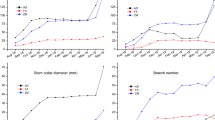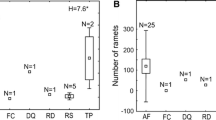Abstract
For species relying on seeds for population regeneration, knowledge on seed germination behaviors in relation to environmental factors is critical in designing species recovery strategy. Dendrobium sinense is an orchid endemic to Hainan Island of China and listed as Endangered by the IUCN Redlist. It reproduces primarily via seeds in its natural habitat. However, how germination is impacted by major environmental factors is poorly known. This study aimed to examine germination success of D. sinense seeds using two approaches, i.e. in situ and ex situ, using host tree barks as germination media. The latter was intended to generate symbiotic seedlings in a simple and economic approach which could be used for reintroduction efforts. In addition, three factors of in situ symbiotic seed germination success, including different sowing time, location (distance from an adult plant), and host tree were investigated. Our results showed that seeds sown ex situ and in situ in July had the highest rates of germination. Seed germination was significantly higher ex situ using bark as medium than in situ. Seeds sown directly on Rhododendron moulmainense, the most common host tree, with naturally occurring conspecific orchids had the highest rate of germination. In contrast, ex situ seeds sown on the bark of Cyclobalanopsis blakeii, a non-host species, had the highest rate of seed germination. In situ a positive correlation was found between the seed germination rate and the distance of the seeds from the adult D. sinense. Based on these results, it is likely seedling recruitments are determined by host tree species, the presence of and the distance from an adult conspecific orchid, which imply the importance of the mycorrhizal fungi, which were not reported here. This study provided important information on the optimal environmental conditions for population augmentation and reintroduction, which can be used as part of the species recovery strategy.




Similar content being viewed by others
Literature Cited
Albrecht M. A. & J. Maschinski. 2012. Influence of founder population size, propagule stages, and life history on the survival of reintroduced plant populations. Page 171–188 in J. Maschinski, and K.E. Haskins, editors. Plant Reintroduction in a Changing Climate: Promises and Perils. Island Press, Washington D.C., U.S.A.
Arditti J. & A.K.A Ghani. 2000. Numerical and physical properties of orchid seeds and their biological implications. New Phytologist 145:146–569.
Atwood, J. T. 1986. The size of the Orchidaceae and the systematic distribution of epiphytic orchids. Selbyana 9: 171–186.
Batty, A.L., K.W. Dixon, M. Brundrett & K. Sivasithamparam. 2000. Soil seed bank dynamics of terrestrial orchids. Lindleyana 15: 227–236.
Batty, A.L., K.W. Dixon, M. Brundrett & K. Sivasithamparam. 2001. Constraints to symbiotic germination of terrestrial orchid seed in a Mediterranean bushland. New Phytologist 152:511–520.
Brundrett M.C., A. Scade, A.L. Batty, K.W. Dixon & K. Sivasithamparam. 2003. Development of in situ and ex situ seed baiting techniques to detect mycorrhizal fungi from terrestrial orchid habitats. Mycological Research 107(10):1210–1220.
Cribb, P. J., S. P. Kell, K.W. Dixon & R. L. Barrett. 2003. Orchid conservation: a global perspective. In Dixon, K. W., S. P. Kell, R. L. Barrett, and P. J. Cribb. Eds. Orchid conservation. Natural History Publications, Kota Kinabalu, Sabah 1–24.
Dalrymple, S.E., E. Banks, G. B. Stewart, and A.S. Pullin. 2012. A meta-analysis of threatened plant re-introductions from across the globe. Page 31–50 in J. Maschinski, and K.E. Haskins, editors. Plant Reintroduction in a Changing Climate: Promises and Perils. Island Press, Washington D.C., USA.
De Long, J.R., N.D. Swarts, K.W. Dixon & L.M Egerton-Warburton. 2013. Mycorrhizal preference promotes habitat invasion by a native Australian orchid: Microtis media. Ann Bot 111: 409–418.
Esitken, A., S. Ercisli, C. Eken, & D. Tay. 2004. Seed priming effect on symbiotic germination and seedling development of Orchis palustris Jacq. Hort Science 39 (7):1700–1701.
Gale, S.W., J. Yamazaki, M.J. Hutchings, Y. Tomohisa & M. Kazumitsu. 2010. Constraints on establishment in an endangered terrestrial orchid: a comparative study of in vitro and in situ seed germinability and seedling development in Nervilia nipponica. Botanical Journal of the Linnean Society 163:166–180.
Godefroid, S., C. Piazza, G. Rossi, S. Buord, A.D. Stevens, R. Aguraiuja, C. Cowell et al. 2011. How successful are plant species reintroductions? Biological Conservation 144(2):672–682.
Guerrant, E.O. J. 2012. Characterizing two decades of rare plant reintroductions. Page 9–30 In: J. Maschinski, and K.E. Haskins, editors. Plant Reintroduction in a Changing Climate: Promises and Perils. Island Press, Washington D.C., USA.
Hay F.R., D.J Merritt, J.A. Soanes, & K.W. Dixon. 2010. Comparative longevity of Australian orchid (Orchidaceae) seeds under experimental and low temperature storage conditions. Botanical Journal of the Linnean Society 164: 26–41.
Hirano, T., K. Ishikawa & M. Mii. 2005. Cryopreservation of immature seeds of Ponerorchis graminifolia var. suzukiana by vitrification. Cryoletters 26 (3):139–146.
Jacquemyn, H., R. Brys, K. Vandepitte, O. Honnay, I. Roldán-Ruiz & T. Wiegand. 2007. A spatially explicit analysis of seedling recruitment in the terrestrial orchid Orchis purpurea. New Phytologist 176(2): 448–459.
Johnson, T.R & M.E. Kane. 2012. Effects of temperature and light on germination and early seedling development of the pine pink orchid (Bletia purpurea). Plant Species Biology 27:174–179.
Liu, H., Y.B.J. Luo., J. Heinen., M. Bhat & Z.J. Liu. 2014. Eat your orchid and have it too: a potentially new conservation formula for Chinese epiphytic medicinal orchids. Biodiversity Conservation 23:1215–1228.
Liu, H., H. Ren, Q. Liu, X. Wen, M. Maunder, & J. Gao. 2015. Translocation of threatened plants as a conservation measure in China. Conservation Biology, 29, 1537–1551.
Maschinski, J. & K. E. Haskins. 2012. Plant reintroduction in a changing climate: promises and perils. Island Press, Washington D.C., USA.
McCormick M.K., D.F. Whigham & J. O’Neill. 2004. Mycorrhizal diversity in photosynthetic terrestrial orchids. New Phytologist 163:425–438
Reiter, N., J. Whitfield, G. Pollard, W. Bedggood, M. Argall, K.W. Dixon, B. Davis, N. Swart. 2016. Orchid re-introductions: an evaluation of success and ecological considerations using key comparative studies from Australia. Plant Ecology 217: 81–95.
Song, X.Q. 2005. Studies on the wild Dendrobium germplasm resources in Hainan Island with special reference to conservation biology of Dendrobium sinense. PhD. Beijing. Beijing Forestry University.
Stewart, S.L., L.W. Zettler. 2002. Symbiotic germination of three semi-aquatic rein orchids (Habenaria repens, H. quinquiseta, H. rnacroceratitis) from Florida. Aquatic Botany 72:25–35.
Tang, M.Y. 2010. DPS data processing system: experimental design, statistical analysis and data mining. Science Press. 178–296.
Xing X., X. Ma, Z. Deng, J. Chen & F. Wu. 2013. Specificity and preference of mycorrhizal associations in two species of the genus Dendrobium (Orchidaceae). Mycorrhiza 23: 317–324.
Yang F.S. 2009. Conservation biology on the base of endophytic mycorrhizal fungi of an endangered orchid Dendrobium sinense. PhD. HaiKou: Hainan University.
Acknowledgements
This work was supported in part by grants from the National Natural Science Foundation of China (31160178, 31160399, 31660227, 31360146), the specialized Fund for Agro-scientific Research in the Public Interest (201303117), Academic Discipline Construction Project Plan in the Central and Western Regions of Hainan University (ZXBJH-XK008), and the Guangxi Science and Technology Bureau (grant no. 12217-04). We thank Jiang Haoyin, Tan Yi and Li Shangzhen for isolation and identification of symbiotic fungi. We are also grateful to Hu Meijiao, Gao Zhaoying, and Wang Jingqiang for field and laboratory assistance.
Author information
Authors and Affiliations
Corresponding authors
Rights and permissions
About this article
Cite this article
Yang, FS., Sun, AH., Zhu, J. et al. Impacts of Host Trees and Sowing Conditions on Germination Success and a Simple Ex Situ Approach to Generate Symbiotic Seedlings of a Rare Epiphytic Orchid Endemic to Hainan Island, China. Bot. Rev. 83, 74–86 (2017). https://doi.org/10.1007/s12229-017-9178-1
Published:
Issue Date:
DOI: https://doi.org/10.1007/s12229-017-9178-1




